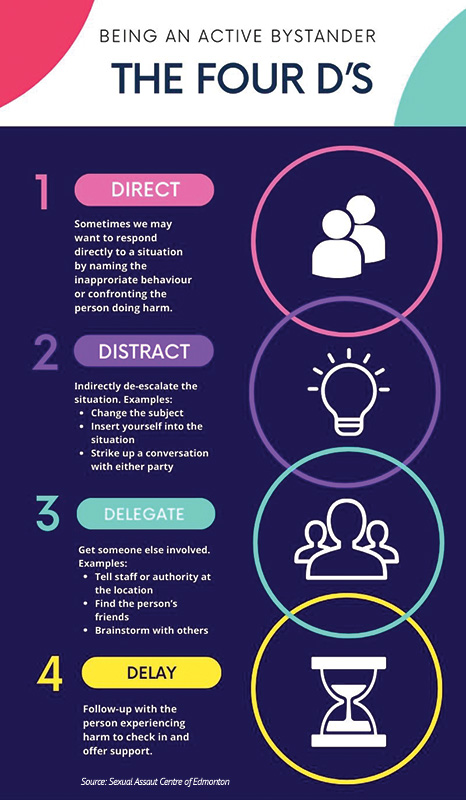The “Four D’s” are different strategies for intervening. Graphic by Brett Browne.
Being an active bystander is an important role that anyone can play when they encounter incidents of gender-based and sexual violence, according to local experts.
Laura Oviedo-Guzmán, system navigator and education specialist with the Chinook Sexual Assault Centre, says an active bystander is essentially someone who gets involved.
“In the literature, they like to call it being an upstander, because you’re not necessary always standing up to someone, but you’re rising to the occasion for someone,” explained Oviedo-Guzmán. “Being an upstander, what that means is being able to identify when someone might need help.”
Corrine Janzen, counselling intake coordinator with Wellness Services at Lethbridge College, adds being an active bystander sends a powerful message.
“It’s extremely important because if we are not being an active bystander, essentially what we’re saying is that those behaviours, those actions that are hurting another person, are okay, she said.
According to Oviedo-Guzmán, there are any number of ways that a person can respond as an active bystander when they witness a harmful or potentially harmful situation. These responses are often referred to as the “Four D’s”, which stands for direct, distract, delegate and delay.
The first “D”, “stands for “direct” and Oviedo-Guzmán said this happens when someone directly intervenes in a situation. It may mean confronting the person who is causing harm or calling out inappropriate behaviour.
The second “D” is “distract” which means using distraction as a way to de-escalate the situation.
“It could be a lot of different things. For example, we could ask the person who is being harassed a question,” said Janzen. “It’s just to distract from what’s happening and disengage the person who is harming the other person.”
Another strategy is to “delegate” which means soliciting help to deal with the situation This could mean involving friends, family, police, an instructor, security personnel or others. According to Oviedo-Guzmán, this strategy is especially important if the bystander does not feel safe.
“The big thing is to intervene only if it’s safe for you to do so,” she said.
The final “D” is “delay” which means delaying action and revisiting the situation at a later to time to offer help or support.
“If we don’t feel comfortable or safe physically or verbally intervening in that situation, we can check in afterwards with that person who was harassed or verbally assaulted,” said Janzen.
Oviedo-Guzmán said one of the most important things an active bystander can do is just be there for someone and find out the best way to help them in that moment, whether that is finding them community resources, listening to their story, or just letting them know you believe them.
“You don’t have to be perfect to be helpful,” she said.Both Oviedo-Guzmán and Janzen encourage people to learn more about becoming an active bystander. They said there is plenty of information available on-line or you may contact the Chinook Sexual Assault Centre at 403-694-1094, visit www.csacleth.ca or contact Wellness Services at 403-320-3206.

